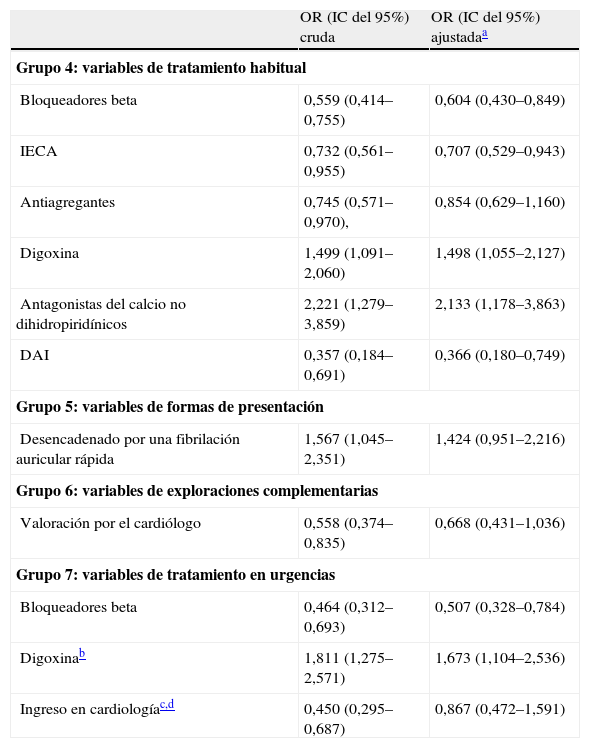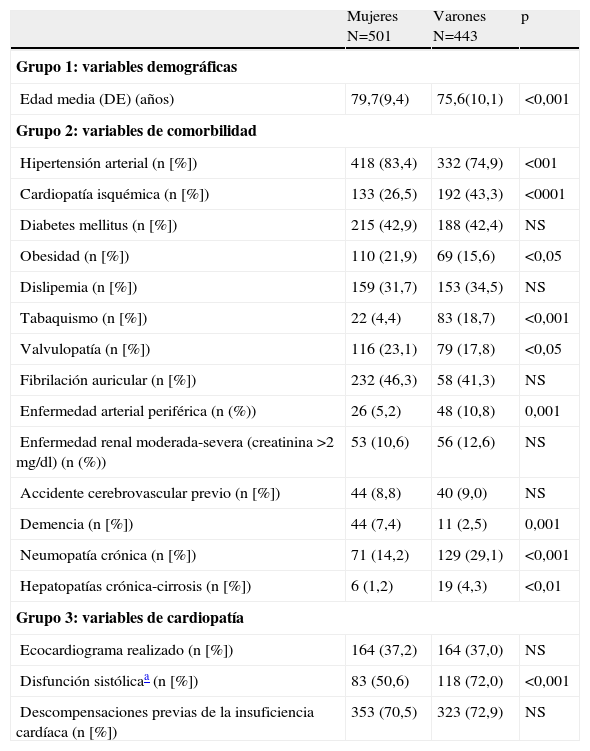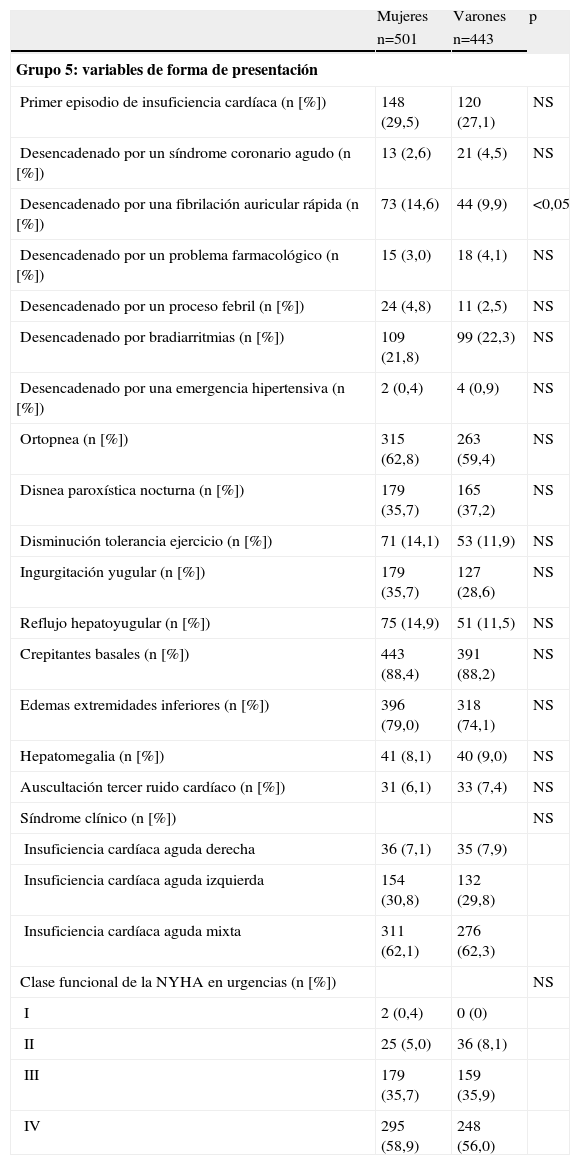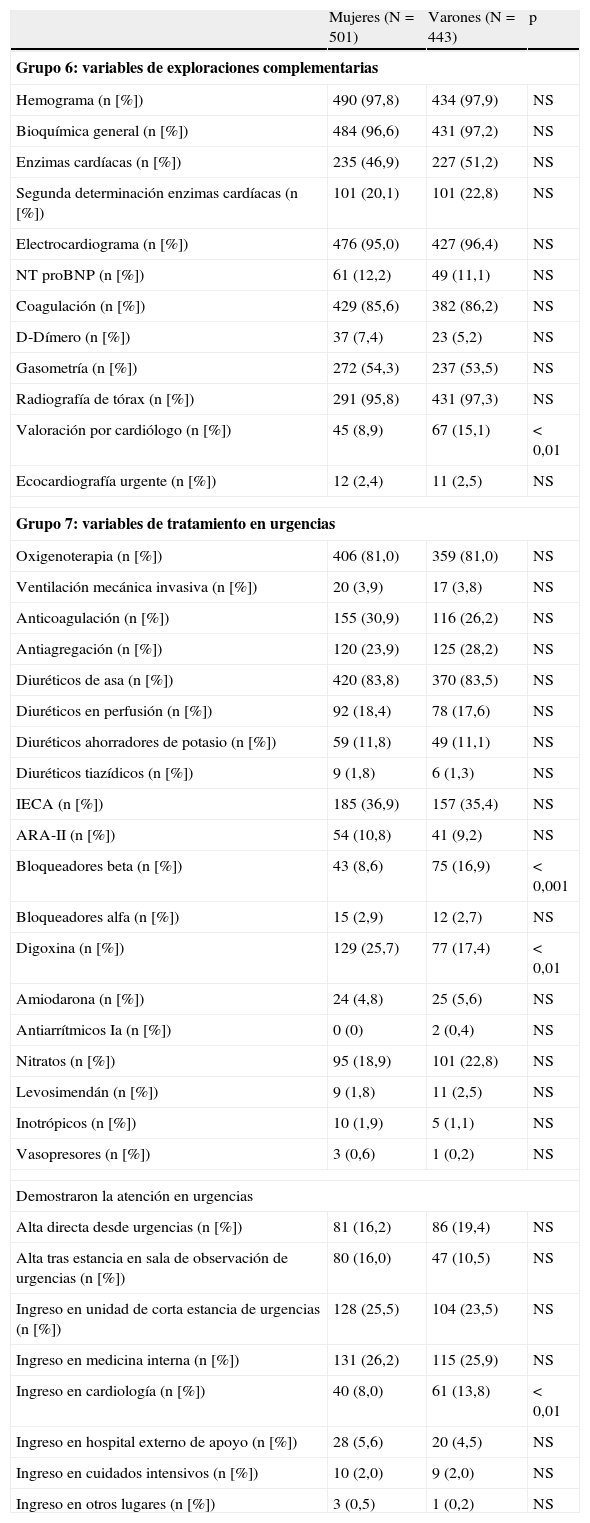Evaluar las diferencias por sexo en la forma de presentación clínica y el abordaje diagnóstico y terapéutico inicial de pacientes con insuficiencia cardíaca aguda (ICA) atendidos en los servicios de urgencias hospitalarios (SUH).
Pacientes y métodosEstudio prospectivo, evaluativo, transversal y multicéntrico, que incluye todos los pacientes atendidos por ICA en 10 SUH españoles entre el 15 de abril y el 15 de mayo de 2007 (n=944). Se registraron variables sociodemográficas, comorbilidad, cardiopatía previa, exploraciones complementarias, tratamiento domiciliario y medidas terapéuticas.
ResultadosLas mujeres (n=501; 53%), con respecto a los varones, presentaron mayor edad (media [DE] de 79 [9] frente a 75 [10] años, respectivamente; p<0,001), hipertensión (el 83,4 frente al 74,9%; p<0,01), valvulopatía (el 23,1 frente al 17,8%; p<0,05) y obesidad (el 21,9 frente al 15,6%; p<0,05) y menor prevalencia de cardiopatía isquémica (el 26,5 frente al 43,3%; p<0,001) y tabaquismo (el 4,4 frente al 18,7%; p<0,001). En el tratamiento ambulatorio, las mujeres son tratadas con menos bloqueadores beta (el 19,6 frente al 30,2%; p<0,001) y antiagregantes (el 34,1 frente al 41,3%; p<0,05). El tratamiento en urgencias fue similar en ambos grupos, excepto que las mujeres recibieron más frecuentemente digoxina (el 25,7 frente al 17,4%; p<0,01). Las mujeres ingresaron menos en cardiología (el 8,0 frente al 13,8%; p<0,01).
ConclusionesEn los SUH se realiza un abordaje diagnóstico y terapéutico de la ICA muy similar en ambos sexos y la mayoría de las diferencias encontradas pueden justificarse por el diferente perfil de paciente y el manejo ambulatorio distinto previo a su consulta en urgencias.
To evaluate the differences by sex in clinic presentation, diagnostic approach and initial treatment in patients with acute heart failure who are attended in emergency rooms.
Patients and methodsProspective, evaluated, descriptive, transverse and multicentric study, which includes all patients attended by acute heart failure in emergency rooms of 10 Spanish centers between April 15th and May 15th, 2007 (n=944). Data were recorded regarding socio-demographic, comorbidity, previous heart disease, complementary explorations, previous home treatment, and therapeutic measurements in emergency.
ResultsRegarding men, women (n=501; 53%) were older (79±9 and 75±10, P<.001), and had more hypertension (83,4% vs 74,9%, P<.01), valvular heart disease (23,1% vs 17,8%, P<.05) and obesity (21,9% vs 15,6%, P<.05); however, they also had less prevalence of coronary heart disease (26,5% vs 43,3%, P=.001) and smoking (4,4 % vs 18,7%, P<.001). According to outpatient treatment, women were less likely to be treated with beta blockers (19,6% vs 30,2%, P<.001) and antithrombotics (34,1% vs 41,3%, P<.05). Treatment administered in the emergency was similar in both groups, yet women received more frequently digoxin (25,7% vs 17,4%, P<.01). Moreover, women were admitted to the cardiology department less often (8,0% vs 13,8%, P<.01).
ConclusionsIn emergency, the diagnostic and therapeutic approach is very similar in both sexes and the most cases, differences can be justified due to the different patients′ profile and the ambulatory handling before their consultation to emergency.
Artículo
Comprando el artículo el PDF del mismo podrá ser descargado
Precio 19,34 €
Comprar ahora











